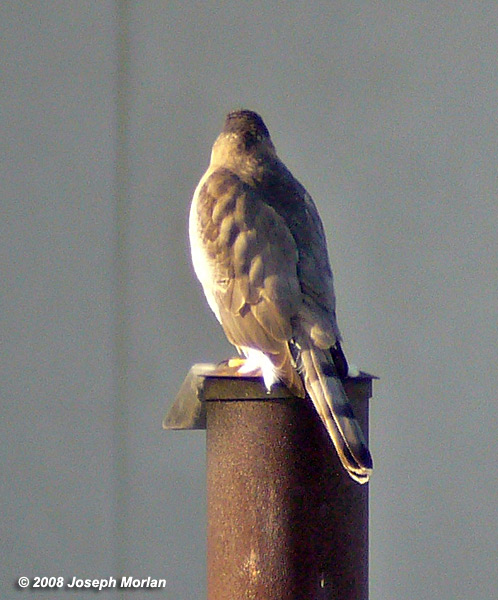


Experts disagree on the identification of this bird. The dark cap, short legs, small eye and fluffy undertail coverts suggest this is an adult Cooper's Hawk. However the tail formula looks more like a Sharp-shinned, possibly because the outer rectrices are being molted. In sum I think it is most likely a Cooper's.
The following analysis comes from Jeff Bouton:
This certainly appears to be an adult male Cooper's Hawk. Although on my
screen the bird appears to be VERY light in coloration (almost gray). Is
this really the way it appeared in the field or a manifestation of the
lighting/images?
Whether the color is accurate though is likely moot. I can point to the
features that make me feel this is otherwise a fairly typical Coop and one
thing about it that is always going to make it look a bit odd. Actually we
can start with the latter first and get that out of the way. This bird
doesn't have its hackle feathers raised making it appear round-headed and
odd (for a Coop's at least). While they can certainly relax these feathers
offering this look more often than not you see them raised offering the very
typical "block-headed" look we expect from 95% or more of the Coops we see.
Now to the nitty-gritty on this bird. First off, given the bluish hue to the
back and reddish orange horizontal barring on the breast/belly we can
immediately move to an adult Sharp-shinned/Cooper's (assuming all of the
world's accipiters are eliminated - I suppose there can be some other
similar birds worldwide "Tiny Hawk" for example). Given the pale eye-color I
would even guess that this is a bird in its 1st adult plumage (when banding
a bird like this you could almost invariably find retained immature
feathering somewhere to confirm your hunch). Also given the bird's lighter
blue/gray coloration I'll take it a step further and suggest this is a male.
None of the guides cover this adequately, but there is a VERY pronounced
coloration difference between the sexes on adult Sharp-shinned and Cooper's
Hawks (in >10,000 birds in the hand I've NEVER found an exception to this
and given the lack of overlap in measurements between sexes this is a data
set of 100% known sex birds!). Adult males invariably get a light blue-gray
like this bird, females are always more of a brown-gray in both of these
species. I don't know why none of the guides have embraced this as I've
never heard of nor seen any exceptions.
So now looking at adult male Sharp-shinned vs. ad male Coop. I point to a
couple of features here that help me cinch this ID. First we can look to the
tail: unfortunately adult male Coops show comparatively short tails and are
the most similar to Sharp-shinneds, but despite not appearing HUGE it does
appear rounded here with a fairly pronounced white tip (not diagnostic in of
itself given the effects of tail wear and molt, but still useful). More
telling however is as seen on image ...295. Adult Sharp-shinneds show a
hooded look because the "buffy-orange" cheek/auricular patch comes ~2/3rd
back on the face leaving a wide pronounced dark strip connecting the cap and
mantle. On Cooper's these light patches are a lot more more extensive
typically blending on the hind neck. Giving the Cooper's that dark-capped
look. This cap is often noticeably darker than the mantle by a shade or two
as well.
We can also look at the tarsi width as another indicator. SSHA have tarsi
that appear as wide as say a typical pretzel stick (at best), Cooper's
always are comparable to (at least) a no 2 pencil approaching a pretzel rod
if you will to make for a better analogy. Works well in the ID seminars...
people like that one!
Another point on the color differences between sexes on adult SSHA vs. COHA
that is useful: Given the extreme sexual-size dimorphism shown by both of
these species (both in measurement and mass) the smallest of the 4 size
classes (ad male SSHA) is SO small in the field that you rarely feel this
bird is large enough to cause confusion. Conversely an adult female Cooper's
Hawk is usually going to appear enormous and will not cause much confusion.
It is the two in between sizes that are going to be closest in appearance
(from a mass standpoint) a large female SSHA and a small male COHA
(apparently still no overlap though according to most sources). So in this
case if you have an adult bird this color difference (very blue (male COHA)
vs. more of a brownish gray (female SSHA)) becomes useful, albeit not
diagnostic in of itself perhaps.
Best,
Jeff Bouton